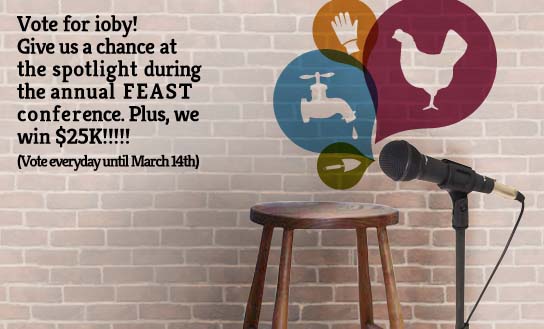We were excited to see ioby covered in Cara Pike’s latest piece in Climate Access that was also picked up in Think Progress. Pike’s piece unpacked resilience, the latest buzzword in use at the Garrison Institute conference Climate, Cities and Behavior Symposium where ioby’s cofounder and Chief Partnerships Officer Cassie Flynn spoke.
Category Archives: Under the Hood
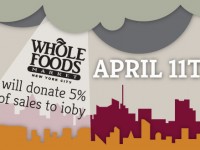
Today is the Day! Whole Foods 5% Day Benefits ioby
That’s right! All day today, all New York City Whole Foods stores are donating 5% of sales to ioby!
We’re so excited about this great partnership for healthier communities, we could shout it from the rooftops and we would love for you to join us.
So, stock up on groceries and know that 5% of your Brussels sprouts and sriracha are going to ioby. Swing by the ioby table in store at all NYC locations, and say hello to our friendly volunteers. And be sure to tell your friends all about this great opportunity to make a big difference for ioby.
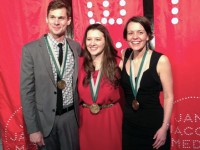
Rockefeller Foundation Awards Jane Jacobs Medal to ioby cofounders
Last night, ioby’s cofounders — Brandon Whitney, Cassie Flynn and Erin Barnes — were awarded the 2012 Jane Jacobs Medal in a new category, New Technology and Innovation.
To ioby, the Jane Jacobs Medal is a huge honor for a number of reasons. First of all, it is very humbling to be counted among great giants in our city — like Ron Shiffman, Rosanne Haggerty and Carl Skelton — who have dedicated their lives to making NYC neighborhoods great places for all New Yorkers, as well as ridiculously important past medalists without whom this city would be very different: Omar Freilla, founder of Green Worker Cooperatives, Peggy Shepard executive director of WE ACT, Alexie Torres-Fleming from YMPJ, Barry Benepe, founder of the Greenmarkets, Damaris Reyes, executive director of Good Old Lower East Side, Richard Kahan, from Urban Assembly, Robert Hammond and Joshua David, cofounders of the High Line, Elizabeth Barlow Rogers from the Central Park Conservancy, Robert DeNiro and Jane Rosenthal, Paul Steely White, the executive director of Transportation Alternatives, and Janette Sadik-Khan, the transformational head of NYC Department of Transportation.
Second, Jane Jacobs, her work and her legacy is very much a part of the ioby spirit. Fiercely concerned with the people who make up cities, their role in political participation and planning and their value in the everyday ballet of the city, Jane Jacobs (de)paved the way for a platform like ioby to exist and thrive.
And finally, Jane herself was, compared to the urban planners, real estate owners, developers and architects, not expert. She was criticized for being unscholarly and challenged experts in urban planning. One of ioby’s founding principles is that people who live in a community know what’s best for the neighborhood. ioby’s role is that of a platform for leaders to bring attention to their work in urban neighborhoods — however expert or nonexpert those leaders may be. Sure, many ioby projects are led by professional urban planners or professors of urban planning or practitioners in architecture or design , and many are not. In fact, most ioby projects are led by a person who has lived in a neighborhood for many years and sees the need for positive change. And that’s as expert as you need to be to lead a project on ioby.
So, outside of being one of the greatest thinkers on urban spaces, urban planning and sociology that the world has ever seen, we would also like to call Jane Jacobs an early ioby project leader and count her among our Backyard Blazers and Heroes in Our Backyards.
Thanks to Edwin Torres, Dr. Judith Rodin, the Rockefeller Foundation, MAS, the ioby Board of Directors, funders, project leaders and donors who have been the lifeblood of our work since the very beginning.

With your vote, ioby will get to present at FEAST!
ioby is a finalist in the Feast’s Rev Up Change! The Feast, in partnership with NBC Universal is awarding a $25,000 prize and speaking opportunity at the 2013 Feast Conference to an innovative project that creates social change in the community.
We really, really want to win. The prize will help even more ioby project leaders to bring their ideas to life, making neighborhoods stronger and more sustainable. To win, we need your help! Can you help us?
To vote, follow these three easy steps.
Step 1: Click here
Step 2: Click on one of the icons
You’ll use Facebook, Gmail, Twitter, LinkedIn or Yahoo to sign in. You’ll need to enter in your login (don’t worry, they won’t use it for anything other than counting your vote).
Step 3: Vote
Once you sign in, you’ll see a big, pink button “VOTE FOR THIS PROJECT.” Click on it.
That’s it! You’ll see a pop-up box that says thank you. And if you can share it on Facebook and Twitter to get more people to vote, that would be amazing. The best part is that you can vote every single day. The more people that vote everyday, the better chance we have to win. If you can take 15 seconds each day to vote for us, we will love you forever. Voting ends March 15.
Thank you so much – your support means the world to us!!
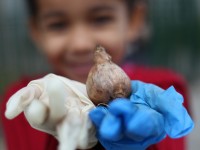
“$49,275 raised, 811 Donors, 43 Neighborhoods, 1 Innovative Foundation” …Get the Full Story on Philanthrogeek
We’re pleased to announce that ioby is a contributor to Philanthrogeek, the new blog dedicated to exploring all the new vehicles for giving, from crowdfunding to SOUPs. Experts from the Awesome Foundation, Pollination Project, and many many more are all joining in the conversation. ioby has kicked off the conversation around crowdfunding and foundation philanthropy with the case study from our Back to School match campaign funded by the Johnson Ohana Charitable Foundation.
To read the article–Crowdfunding + Foundation Philanthropy = Leveraged Community Engagement and Giving–in full, click here.

“A Gift of the Whole People”: How Crowdfunding Can Help Revitalize National Parks
ioby is proud to announce a new partnership with the National Parks Conservation Association to crowdfund projects in our country’s beloved national parks. It sounds like a cutting-edge idea, and it is—though another cause beat us to the punch by more than a hundred years.
In the late 19th century, French writer and political figure Edouard de Laboulaye came up with the idea for France to give to the United States a symbol of liberty, 100 years after Bastille Day and the signing of the Declaration of Independence.
The Statue of Liberty was built in two parts. French cities, towns, and individuals contributed two million francs, securing all the necessary funding for the statue’s steel and copper by 1880. But, years later, the United States, still embroiled in a rivalry of which city–Philadelphia, Boston, or New York City–would be the statue’s home state, was unable to come up with the money to build the pedestal upon which Lady Liberty would stand.
Newspaper publisher Joseph Pulitzer had recently purchased the New York City daily, The World. He decided to take up the cause for New York City and inadvertently launched the first American crowdfunding campaign. On March 16, 1885, The World ran this plea:
We must raise the money! The World is the people’s paper, and now it appeals to the people to come forward and raise the money. The $250,000 that the making of the Statue cost was paid in by the masses of the French people—by the working men, the tradesmen, the shop girls, the artisans—by all, irrespective of class or condition. Let us respond in like manner. Let us not wait for the millionaires to give us this money. It is not a gift from the millionaires of France to the millionaires of America, but a gift of the whole people of France to the whole people of America.
By August 11, 1885, the campaign brought in 125,000 donations totaling $100,000, many people donating less than a dollar each to create the foundation for this great symbol of liberty, now managed by the National Park Service.
Today, NPCA and ioby join together continue this great legacy of utilizing citizen philanthropy to support more of our nation’s urban national treasures.
ioby was created for all people who say, “Yes, I want positive change in my community!” On ioby, anyone with a great idea to make her neighborhood stronger and more sustainable can raise tax-deductible donations, recruit local volunteers, and share ideas in a like-minded community.
ioby began as a pilot program in New York City and has a special interest in supporting projects in dense urban centers, which is why we are so excited to be working on this partnership with NPCA and their community partners, National Aquarium (Baltimore, MD), Tropical Audubon Society (Miami, FL), and Roots and Wings (Los Angeles, LA), who are dedicated to connecting city dwellers to the great outdoors.
We launch the pilot today with three great campaigns. In Baltimore, the National Aquarium and National Park Service will recruit volunteers to clear and maintain trails at the wetland adjacent to Fort McHenry National Monument and Historic Shrine. Tropical Audubon Society will lead kayaking trips in Biscayne Bay in Miami. In Los Angeles, the Roots and Wings Program will bring high school students on outdoor adventures into five different western national parks.
These crowdfunding campaigns are not so different from the campaign to fund the Statue of Liberty. Sure, we have some advantages. Web tools make collecting donations easier and social channels like Facebook and Twitter help us amplify these stories and visions.
But the premise is not unlike what Mr. Pulitzer posed in 1885. Combined with thousands of other small donations, a single dollar gains power. With others, the voice of a lone micro-donor grows louder, and says, “Yes, I want healthy wetlands in Baltimore!” and, “Yes, I support kayaking trips in Biscayne Bay!” and “Yes, I want Los Angeles youth to visit more national parks!”
Learn more about easy ways you can contribute a dollar (or more) to the parks and say “yes!” to other important causes at ioby.org/NPCA.
Resilience is Personal: Thoughts from Cassie
“Resilience” is a word you hear a lot in the aftermath of a disaster. Indeed, it’s critical to think about how we can be less vulnerable in the future. In New York City during Hurricane Sandy, we saw firsthand how a downed transportation system can bring the city to a halt. After the earthquake in Haiti, we talked a lot about how to make buildings more stable by improving building codes. These conversations are incredibly important, and help us to plan for what we hope will never happen.
I have been thinking about what it takes to be resilient for a while. Before joining ioby as staff, I worked at the United Nations Development Programme as a Climate Change Policy Specialist. I supported national governments to address climate change within their countries and at the negotiating table at the UNFCCC negotiations. In my work, I spoke with people addressing disasters around the world: the floods in Pakistan, earthquake in Japan, typhoons in the Philippines and other tragedies.
Here is what I learned: resilience is personal.
When the storm hits, it’s the things that you barely thought about before the disaster that are crucial. Questions that you probably never asked yourself before in any urgent way: How can I get food and water? How can I communicate with my family and friends? If I need to leave my home, how do I get out?
In my experience, people that could answer questions like these are much more resilient to the impacts of the disaster. And in New York City, we saw this vividly – stories of the elderly stuck in apartments at the tops of buildings with no way to get food or power. They depended on the incredible army of relief workers, volunteers and concerned citizens to bring them supplies. By getting their personal needs met, they were more resilient.
Don’t get me wrong – personal resilience is very connected to the resilience of larger systems. You can’t call your family if the telephone lines are out. But in a disaster my first though isn’t “what’s going on with the grid?” It’s “How do I call my family? NOW.”
This is why I am proud of ioby’s report after Hurricane Sandy. While there have been many important discussions about how we can improve larger infrastructure – like energy grids, buildings and transportation systems – to be less vulnerable to erratic storms, ioby’s is the first to make this personal. When we asked people for ideas, we didn’t know what we would get. And the responses surprised in all sorts of good ways. Many suggestions are wildly practical and don’t cost a lot of money. Ideas like having a “buddy” in your apartment building to make sure that everyone is accounted for after a disaster. Imagine how that would have helped in the days following Sandy? Or Katrina?
I hope this is just the beginning of more efforts to talk about resilience from the personal perspective. There is no doubt that we need to rebuild in smarter, stronger ways and it will require good ideas from everyone so that, if a storm like Sandy comes our way again, we will be ready with good answers to the unexpected questions.
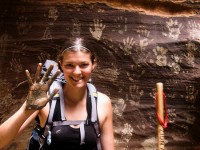
Meet Karja Hansen. Welcome ioby to Miami.
Had you asked me prior to the summer of 2010 if I would ever consider living in Miami, I would have quickly answered no. I’d never been to Miami, but I’d been to Orlando, and Miami was south of that humid hot mess, and from what little I knew of it, populated by shopping malls, sprawl and body obsessed party-goers. Not really my thing. But, I was offered an incredible opportunity to work with incredible visionaries and leaders in my field, and the catch was that they were in Miami. So, I sucked it up and moved on down, expecting to hate Miami but just deal with it. And, wow, was I surprised.
I am just bursting with excitement about ioby en Miami! I’m not much of a morning person, but here I am, up and writing at 6:50 am – a time when I usually have no interest in, or awareness of, anything but my pillow.
Miami blew me away. In addition to being a tropical paradise and a cyclists dream (topographically anyhow – definitely not from a facility or safety perspective), Miami has serious assets and burgeoning energy. A young city-region, Miami-Dade is comprised of great historic centers which have seen an astonishing comeback over the past 20 years, starting with Coconut Grove and South Beach, but now having spread to almost every place with a walkable, dense, mixed use makeup – and there are many of them, having originated along the Flagler rail and streetcar lines (now defunct or torn up). The sprawl is still a major issue, the transit comes up sorely short, the government is decidedly Caribbean – don’t get me wrong, there are some serious challenges here. But there are also incredible assets and opportunities, across the board. People, especially younger people now, are moving here from all over to build, together, their own vision of how life should be lived – and, for the first time in a long time, they are intermingling with the natives. Imagine my surprise when I gushed to an awesome native Miamian about how exciting it was to meet someone doing something cool who was actually FROM Miami – and was told, in response, that she felt the same way every time she met someone doing something cool who WASN’T from Miami (Jeremy Glaezer wrote a great piece on this, here).
The native-newcomer interaction is an important one, bridging a divide that has yawned wide for decades. But, it follows on the heels of a bevy of boundary crossing uniting forces unique in this city. Add to that list the fact that we here are literally on the forefront of climate change and sea level rise – and you can begin to understand how greater Miami and South Florida in general is becoming a leader of renaissance regions.
This is just the tip of the iceberg of why I am so excited to be living and working in Miami, against all expectations. The change I have witnessed in my two short years in the city, the energy that is greater every day, the diversity and the push for change, for a better world, is so clear and central in the Miami I have come to know. But, like all great movements early in their life, much of the energy and effort is still happening in isolation, struggling to succeed. And this is where ioby comes in. The digital community-making tools and resources provided by ioby the platform are transformational – and easy to use. But, this is not necessarily unique. What truly distinguishes ioby is the people behind these tools and resources. I have what some would call a spotty employment history, as do many of my generation, because I have always pursued avocation over employment. I have always had a driving need to be putting my time and effort towards something meaningful that continued to expose me to new knowledge and experience. What I have come to know of the people behind ioby floors me. The passion, dedication and ability – not to mention enjoyment – with which they pursue their work is what has been long missing from the job market and economy. Pair this with the vision and foresight of the Miami Dade County Office of Sustainability, inviting ioby to come here and operate and help accomplish the goals of the GreenPrint plan, and the support of the Health Foundation of South Florida and the funders network to do so – we’ve got a dynamic and multi-talented partnership.
I am so excited to be joining ioby and bringing life to their Miami office. I look forward to sharing my efforts and experiences in the coming days, and to working with many of you. Lets set the world to rights, live and support a lifestyle that contributes to our shared bottom lines, and get back to aspiring and inspiring endeavors!
Get Involved
Karja is our new Miami Project Recruiting Manager. She’s a composting, tree-hugging, locavoring, kayaking, chicken-loving urbanist, and she is very excited to talk to you about supporting your ideas to make your neighborhood more awesome. Learn more about her, and the rest of the ioby team, here. Karja is always often on the go, meeting the people living and working in Miami-Dade and helping them to make their ideas for a greater Greater Miami become reality. Get in touch to visit with her in YOUR backyard: email her at karja [at] ioby [dot] org, or call her at 305.428.2705.
Funders’ Network for Smart Growth and Livable Cities Backs ioby Expansion
We are incredibly proud to announce our newest partnership with the Miami-Dade County Office of Sustainability. The staff at OOS—innovative leaders, fiercely dedicated to the future of Miami-Dade—invited ioby to replicate in Miami as an implementation partner on their five-year sustainability plan, GreenPrint. We could not be more excited about the opportunity, and we are very grateful to our lead funders, the Funders’ Network for Smart Growth and Livable Communities and the Health Foundation of South Florida for their support.
“It’s an innovative partnership that will help us engage the community—that’s where the good work gets done. ioby is a really great way for us to say to the residents of Miami-Dade County, GreenPrint is a plan for you.” — Nichole Hefty, Manager, Office of Sustainability Miami-Dade County
ioby’s office in Miami is funded by a special grant called the “Local Sustainability Matching Fund” (LSMF), which is a collaborative effort of the Funders’ Network and the Urban Sustainability Directors Network (USDN). LSMF is designed to catalyze partnerships between local governments and local, place-based foundations that advance on-the-ground sustainability projects, processes, and programs. We are very grateful to the philanthropic cohort supplying the national “matching pool” of funding which includes Surdna, the Kendeda Fund, New York Community Trust, Summit Foundation, and JPB Foundation.
Under the Hood: How to Throw a Killer Gala for $342.61
As ioby's second annual benefit is just one week away, we have taken the opportunity to reflect on some lessons from last year's gala, and we decided to share them with you.

For those of you who came to ioby's First Benefit in November of last year, you remember that it was a great gathering of the nearly 300 people who have played a very important role in ioby's first full year at work. About a month after the event, I went back through all the receipts and assessed the budget versus actuals. I knew that we were going to come in very close to our target, but it was actually a little staggering how close we really came. Not including staff time*, the value of our gala was $31,975, but we only spent $342.61 from our operating budget. It wasn't that hard to do, besides the actual value of the gala is priceless and there are many moments in an organization's growth when an event is appropriate and can be very beneficial.
Step 1. Buy the Cause Effective Special Events Toolbox.
No, we're not getting paid by Cause Effective to promote their book. It really is that good. In fact, it's so good, I'm even going to tell you that it's worth every penny of the $50 it cost us. The book came recommended to us in a workshop on special events planning led by NYCAHN and Dara Silverman. The Toolbox gives step by step instructions and samples from various event types, everything from a cocktail party to a film screening. There are sample budgets, invitations and timelines as well as lessons learned from combined decades of experience (my favorite: "Bring an extra pen. Someone will borrow it and not return it." It truly is the nuts and bolts of event planning and execution. Buy it.
Step 2. Know Your Objectives.

As a brand new organization, we knew that our first objective of our first event had to be establishing ioby's name. Moreover, because we are a community-based organization that primarily works online, we wanted our event to be an opportunity to drive home that ioby is much, much more than just a website. Our second objective was to thank the many people who helped ioby get off the ground and specifically to spotlight the work of the project groups that we felt exemplified ioby's mission. Our third objective was to raise funds, both for ioby's operations and for ioby projects. This is an important note. We wanted to do both in a way that was the simplest and the most engaging. We wanted to make sure people understood that our mission is very much about putting money in what you believe in. Not a lot of money, but just something to show you really care. Skin in the game, they say. Our fourth objective was to double the number of potential micro-donors in the room that night. So, it was from this careful calculation that came our Giving Card.

Co-designed by Shana Agid's Parsons class in printmaking, the ioby giving card took nearly 50% of our ticket sale revenue and allowed guests to give it back directly to projects of their choice. The card was created to be an on-ramp to philanthropy as well as a new donor cultivation tool. Some people have talked about this card as an example of post advertising and cause marketing.

Step 3. Ask for Help.
Not everyone likes fundraising, but anyone can ask for help. You need someone to make a cocktail. Ask your friends: do you know anyone who can make a cocktail? Chances are someone does. You need some candles that won't hurt the environment. Someone will be able to help you find someone who can donate them. ioby has a lot of good people in our network and we were able to get $29,132 of in kind donations for our event.
We had everything from the space (Brooklyn Brewery), the red carpet and step & repeat (City Eventions), the food (Dirt Candy and JoeDoe to prepare, Whole Foods to deliver the groceries), the drinks (Brooklyn Brewery, Tuthilltown Spirits, Gotham Project Riesling, Kombucha Brooklyn), decor (Upscale Lighting, GoodLight Natural Candles, City Eventions) and auction items (Al Gore, Patagonia, Bill McKibben, Green Fitness Studio, Irene Boland, Franny's, Larder, Green In BKLYN, Elizabeth Royte, Steve Keene, Kombucha Brooklyn, Math-You Namie, Holstee, Lebak Farms, Argus New Seeds and Christoph Niemann) donated to us in kind and we are incredibly grateful to these local, corporate sponsors who made our event a huge success.

Step 4. Know Your Base.
We have all been to terrible events. It's crowded. You're in the back. Someone is droning into a microphone and you can't understand them through the echo. You leave and even though you really love the mission of the organization, you really had a mediocre night. Yes, we gave awards to the ioby Heroes, but no, we did not have an awards ceremony. Yes, we had a gala, but we did not have any white tablecloths.
The ioby base is largely DIY, community service-oriented, creative thinkers and do-gooders. These are not the people who appreciate fancy plated dinners or long boring talks at the mic.
Our two biggest event sponsors (City Eventions and the Fledgling Fund) gave us $1,000 cash each. Combined with our other sponsors, Tuthilltown Spirits, NRDC and Partnerships for Parks, our cash budget for the event was $2,500. We dug deep into our best creative scrappy selves and quickly apples became our table decorations. We banned food that required utensils to avoid renting cutlery. We gave ioby whiskey glasses as gifts so we wouldn't have to rent 1,200 wine glasses. We had an art installation and gave awards provided by State Senator Eric Adams. Burlap ($44/bolt) became our tablecloths. And at the same time, we stuck to our organization's mission: the large majority of ingredients and products are locally made, we provided vegan/vegetarian food, our event was subway-accessible, we composted our scraps.

Step 5. Build a Great Team.
There's nothing I'm more grateful for than the volunteers, planning committee and host committee that made our event happen. There's no way that our staff of two people could have pulled off an event like this. We had volunteers pitching in the morning of to squeeze 200 lemons, there were volunteer photographers, serious grunt workers who hauled ice in the middle of the gala when we ran out, volunteers installed the art exhibit, checked coats and sold raffle tickets. This is also the one area that I think we could have done more. We could have had a better, more explicit system set up to support our volunteers. We were lucky that our volunteers were by nature problem-solvers and self-starters and they were able to run much of the event without direction. But we should have had better systems for them to take breaks and to eat dinner and to see their friends.
Step 6. Use Eventbrite.
Eventbrite takes $0.99 + 5.5% per ticket but they deserve it. We never had a single hiccup. It integrates really smoothly with Mail Chimp and embeds everywhere. Their Facebook integration works so well, it's like they're stalking your friends in dark alleys late at night, demanding that they buy tickets to your event. The CMS is simple and the WYSIWYG was slightly easier than what we've used with WordPress and Mail Chimp. The large majority of our base is online, so an online invitation made sense for us. Paper invitations are wasteful and costly. We saved gobs of time, money and trees this way.
Step 7. Plan. Follow the Plan.
I'm not a planner by nature. I generally rely on winging it. But when you're bringing together the 300 most important people to the first event of an organization you founded, the pressure is on to make sure nothing goes wrong. So, when you make an email marketing calendar to sell tickets, follow it. Meet your own deadlines and make sure other people meet theirs. In the end, we felt like we met all our objectives. We raised $11,000 in ticket sales and auction/raffle funds. These funds were crucial to our 2010 organizational budget, but because of our dual fundraising objective, we set aside $6,000 of our income to be delivered back to projects through our Giving Card. Stay tuned for our report on how the Giving Card worked, coming up soon in Under the Hood.

*A note on human resources.
Staff time is often the forgotten budget line item in event planning. In total, ioby staff spent 432 hours planning, implementing and doing follow up for our gala, which roughly estimates at $35/hr to $15,000. This is a significant line item that I did not include in my overall budget numbers above. We made the decision at the outset that this was an important enough event that a significant amount of human resources would be dedicated to it. Be sure to plan and set aside an appropriate amount of staff resources based on what you actually believe you will achieve with your event.
See it for yourself. Join us on Thursday, November 3 at 7pm at Brooklyn Brewery. Tickets here: http://iobybenefit2.eventbrite.com/

